BODYVORK ON PARADE
Page 68
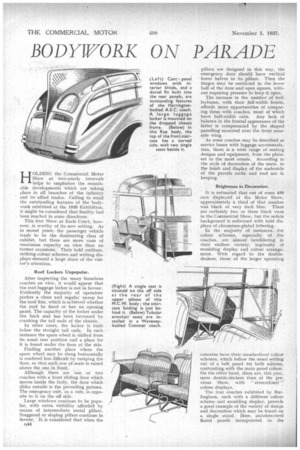
Page 69
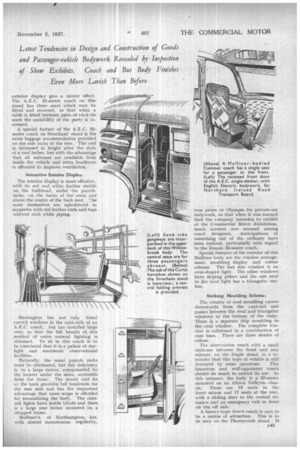
Page 70
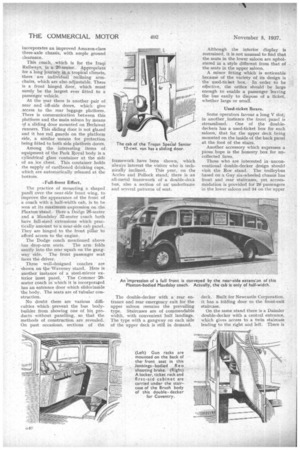
Page 72
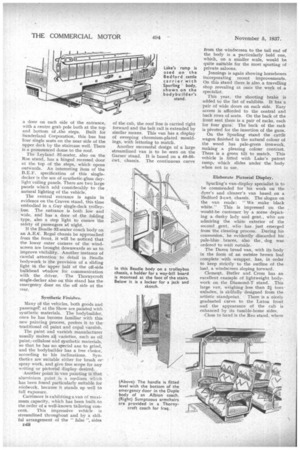
Page 73
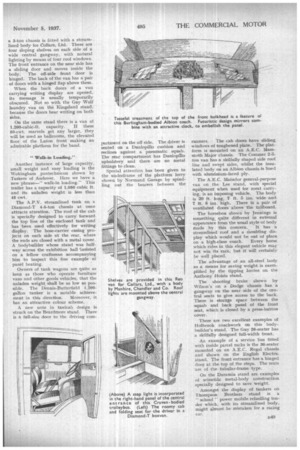
If you've noticed an error in this article please click here to report it so we can fix it.
HOLDING the Commercial Motor Show at two-yearly intervals helps to emphasize the remarkable developments which are taking place in all branches of the industry and its allied trades. Calling to mind the outstanding features of the bodywork exhibited at the 1935 Exhibition, it might be considered that finality had been reached in some directions.
This first Show at Earls Court, however, is worthy of its new setting. As in recent years, the passenger vehicle tends to be the dominating class of exhibit, hut there are more vans of maximum capacity on view than on former occasions. Their bold outlines, striking colour schemes and writing displays .demand a large share of the visitor's attention.
Roof Lockers Unpopular.
After inspecting the many luxurious coaches on view, it would appear that the roof luggage locker is not in favour. Evidently the majority of operators prefers a clean and regular sweep for the roof line, which is achieved whether the roof be fixed or has an opening panel. The capacity of the locker under the back seat has been increased by cranking the tail ends of the chassis.
In other cases, the locker is built below the straight tail ends. In each instance the spare wheel is shifted from its usual rear position and a place for it is found under the floor at the side.
Finding another place where the spare wheel may be slung horizontally is rendered less difficult by ramping the floor, so that each row of seats is raised above the one in front.
Although there are one or two coaches with a front sliding door which moves inside the body, the door which slides outside is the prevailing pattern. The emergency exit, as a rule, is opposite to it on the off side.
Large windows continue to be popular, with extra visibility afforded by means of intermediate metal pillars. Staggered or sloping pillars continue in favour. It is considered that when the D44 pillars are designed in this way, the emergency door should have vertical lower halves to its pillars. Then the hinges may be restricted to the lower half of the door and open square, without requiring pressure to keep it open.
The increase in the number of trolleybuses, with their full-width fronts, affords more opportunities of comparing them with coaches, most of which have half-width cabs. Any lack of balance in the frontal appearance of the latter is compensated by the shaped panelling mounted over the front nearside wing.
As some coaches may be described as service buses with luggage accommodation, there is a wide range of seating designs and equipment, from the plainest to the most ornate. According to the style of decoration of the seats, so the finish and display of the underside of the parcels racks and roof are in keeping.
Brightness in Decoration.
It is estimated that out of some 450 cars displayed at the Motor Show, approximately a third of that number was black or very dark blue. There are certainly two or three black vans in the Commercial Show, hut the sedate background is enlivened with hold displays of chromium-plated lettering.• In the majority of instances, the colour schemes, especially of the coaches, are almost bewildering in their endless variety, ingenuity of moulding display and colour arrangement. With regard to the doubledeckers, those of the larger operating concerns have their standardized colour schemes, which follow the usual setting out of a belt panel for both saloons, contrasting_with the main panel colour. On the other hand, there are, this year, more double-deckers than at the previous Show, with " streamlined 7 colour displays.
The four coaches exhibited by Burlingham, each with a diffdrent colour scheme and moulding display, provide a good example of the variety of design and decoration which may be found on a single stand. Here, stainless-steel flared panels incorporated in the exterior display give a mirror effect. The A.E.C. 32-seater coach on this stand has three seats which may be lifted and reversed, so that when a table is fitted between pairs of vis-a-vis seats the sociability of the party is increased.
A special feature of the A.E.C. 32seater coach on Strachans' stand is the extra luggage accommodation provided on the side racks at the rear. The tool' is increased in height after the style of a roof locker, but with the advantage that all suitcases are available from inside the vehicle and extra headroom is afforded to improve ventilation.
Attractive Interior Display.
The interior display is most effective, with its red and white leather motifs on the bulkhead, under the parcels racks, on the hacks of the seats and above the centre of the back seat. The seats themselves are upholstered in moquette with red leather ends and tops relieved with white piping.
Harrington has not only fitted curved windows in the cant-rails of an coach, but has installed 'large ones, so that the full benefit of this method of extra natural lighting is obtained. To sit in this coach is to be convinced that it is a palace of daylight and maximum observational facilities.
Naturally, the usual parcels racks must be eliminated, but this deficiency is, to a large extent, compensated by the lockers under the seats, accessible front the front. The dorsal roof fin at the back provides full headroom for the rear seat and has the important advantage that more scope is afforded for streamlining the body. The cantrail lights have inside blinds and there is a large rear locker mounted on a dropped frame.
Mulliner's, of Northampton, has, with almost monotonous regularity, won prizes at Olympia for private-car bodywork, so that when it was learned that the company intended to exhibit at the Commercial Motor Exhibition, much interest was aroused among coach designers. Anticipations of something out of the ordinary have been realized, particularly with regard to the Dennis 32-seater coach.
Special features of the exterior of this Mulliner body are the window arrangement, moulding display and colour scheme. The last side window is an oval-shaped light. The other windows have sloping pillars and the one next to the oval light has a triangular outline.
Striking Moulding Scheme.
The cornice or roof moulding curves downwards from the cant-rail and passes between the oval and triangular windows to the bottom of the body. There is a separate drip moulding to the oval window. The complete window is cellulosed in a combination of rose hues. There are three shades of colour.
The observation coach with a small staircase between the front and rear saloons, on the Duple stand, is a reminder that this type of vehicle is still favoured by some operators. This luxurious and well-appointed coach should do much to extend its use, In this instance, the body is a 35-seater mounted on an Albion Valkyrie chassis. There are 18 seats in the front saloon and 17 seats at the rear, with a sliding door to the central entrance and an emergency exit in front on the off side.
A luxury-type desert coach is sure to be a centre of attraction. This is to be seen on the Thorn■,-croft stand. It D45 incorporates an improved Amazon-class three-axle chassis, with ample ground clearance.
This coach, which is for the Iraqi Railways, is a 20-seater. Appropriate for a long journey iri a tropical climate, there are individual reclining armchairs, which are also adjustable. There is a front hinged door, which must surely be the largest ever fitted to a passenger vehicle.
At the rear there is another pair of near and off-side doors, which give access to the rear luggage platform. There is communication between this platform and the main saloon by means of a sliding door mounted on Beclawat runners. This sliding door is not glazed
and it has rail guards on the platform•side, a similar -means for protection
heing fitted to both side platform doors.
Among the interesting items of equipment of the Park Royal body is a cylindrical glass container at the side of an ice chest. This container holds the supply of cardboard drinking cups, which are automatically released at the bottom.
-Full-front Effect.
The practice of mounting a shaped panel. over the near-side front wing, to improve the appearance of the front of a coach with a half-width cab, is to he seen at its maximum expression on the Plaxton stand. Here a Dodge 26-seater and a Islandslay. 32-seater coach both have full-sized extensions which practically amount to a near-side cab panel. They are hinged to the front pillar to afford access -to the engine. •
The Dodge coach mentioned above has drop-arm seats. The arm folds neatly into the rear squab on the gangway side. The front passenger seat faces the driver.
Three well-designed coaches are shown on the -Waveney stand. Here is another instance of a steel-Mirror exterior inset panel. The Commer 20seater coach in whichit is incorpora/ed has an entrance door which slides inside the body. The seats are of tubular construction.
No doubt there are various difficulties which prevent the bus bodybuilder from showing one of his products without panelling, so that the methods of construction are revealed. On past occasions, sections of the framework have been shown, which always interest the visitor who is tech nically inclined. This year, on the Accles and Pollock stand, there is an franicwork of a double-deck bus, also a section of an underframe and several patterns of seat.
The double-decker with a rear entrance and rear emergency exit for the upper saloon remains the prevailing type. Staircases are of commendable width, with convenient ball landings. The type with a gangway on each side of the upper deck is still in demand.
Although the interior display is restrained, it is not unusual to find that the seats in the lower saloon are upholstered in a style different from that of the seats in the upper saloon.
A minor fitting which. is noticeable because of the variety of its design is the used-ticket box. In order to be effective, the orifice should be large enough to enable a passenger leaving the bus easily to dispose of a ticket, whether large or small.
Used-ticket Boxes.
Sortie operators favour a long V Slot; in another . instance the front panel is streamlined. One of the doubledeckers has a used-ticket box for each saloon, that for the upper deck being mounted on the inside of the back panel at the foot of the stairs.
Another accessory which expresses a pious hope is the honesty box for uncollected fares.
Those who are interested in -unconventional double-decker design should visit the Roe stand. . The trolleybus based on a Guy six-wheeled chassis has front and rear staircases, yet accommodation is provided for 26 passengers in the lower saloon and 34 on the upper deck. Built for Newcastle Corporation, it has a folding door to the front-exit staircase.
On the same stand there is a Daimler double-decker with a central entrance, which gives access to a twin staircase leading to the right and left. There is a door, on each side of the entrance, with a centre grab pole both at the top and bottom of -the steps. Built for Sunderland Corporation, this bus has lour single seats on the near side of the upper deck by the staircase well. There is a pronounced dome to the roof.
The Leyland 32-seater, also on the Roe stand, has a hinged recessed door at the top of the steps, which opens outwards. An interesting item of the B.E.F. specification of this singledecker is the use of synthetic-glass daylight ceiling panels. There are two large panels which add considerably to the natural lighting of the vehicle.
The central entrance is again in evidence on the Craven stand, this time embodied in a Guy single-deck trolleybus. The entrance is both low and wide, and has a door of the folding type, also a step light to ensure the safety of passengers at night.
If the Beadle 32-seater coach body on an A.E.C. Regal chassis be approached from the front, it will be noticed that the lower outer corners of the windscreen are brought downwards so as to improve visibility. Another instance of careful attention to detail in Beadle bodywork is the provision of a sliding light in the upper half of the off-side bulkhead window for communication with the driver. The Thornycroft single-decker also on this stand has the emergency door on the off side at the rear.
" Synthetic Finishes.
Many of the vehicles, both goods and passenge?; at the Show are painted with synthetic materials. The bodybuilder, once he has become familiar with this new painting process, prefers it to the traditional oil paint and copal varnish.
The paint and varnish manufacturer usually makes al varieties, such as oil paint,--cellulose and synthetic materials, so that he has no special axe to grind, and the bodybuilder has a free choice, according to his inclinations. Synthetics are suitable either for brush or' spray work, and give free scope for any writing or pictorial display. desired.
Another point in van painting is that aluminium paint is a medium which has been found particularly suitable for roofwork, because it stands.up well to full exposure.
Carrimore is exhibiting a van of maximum capacity, which has been built-to the order of a well-known tailoring concern. This impressive vehicle is streamlined throughout and by a skilful arrangement of the " false sides of the cab, the roof line is carried right forward and the belt rail is extended by similar means. This van has a display of sweeping chromium-plated mouldings, with lettering to match.
Another successful design of a large streamlined van is to be seen on the Garner stand. It is based on a 40-50cwt. chassis. The continuous curve from the windscreen to the tail end of the body is a particularly bold one, which, on a smaller scale, would be quite suitable for the most sporting of private saloons.
Jennings is again showing horseboxes incorporating recent improvements. On this stand there is also a travelling shop revealing at once the work of .a specialist.
This year, the shooting brake is added to the list of exhibits. It hes'a -pair of wide doors on each side. Easy access is afforded to the central and back rows of seats. On the back of the front seat there is a pair of racks, each for four guns: The back of the rack is pivoted for the insertion of the guns.
On the Spurling stand the cattle wagon finished in the natural colour of the wood has pale-green ironwork, making a pleasing colour contrast. There is a green tilt to match. This vehicle is fitted with Lake's patent ramp; which slides under the body when not in use
Elaborate Pictorial Display.
Spurling's van-display specialist is to be commended for • his work on the dyer's and cleaner's van based on a Bedford 3-cwt. chassis. The slogan on the van reads: " We make black white." This is impressed on the would-be customer by a scene depicting a dusky lady and gent., who areadmiring the white exterior of the second gent. who has just emerged from the cleaning process. During his conversion, he evidently discarded his pale-blue braces, also the, dog was ordered to wait outside.
The Daren bread van, with its body in the form of an outsize brown loaf complete with wrapper, has, in order to keep strictly• to the outline of the loaf, a windscreen sloping fonvard.
Clemeut. Butler and Cross has an excellent example of lightweight bodywork on the Diamond-T stand. This large van, weighing less than 21 tons' unladen, is skilfully designed from the artistic standpoint. There is a nicely graduated curve to the Luton front and the appearance of the cab is enhanced by its tumble-home sides.
Close to hand is the Reo stand, where a 3-ton chassis is fitted with a streamlined body for Collars, Ltd. There are four sloping shelves on each side of a wide central gangway, with natural lighting by means of four roof windows. The front entrance on the near side has a sliding door and moves inside the body. The off-side front door is hinged. The back of the van has a pair . of doors with a hinged flap above them.
When the back doors of a van carrying writing display are opened, its message is usually temporarily obscured. Not so with the Guy Wolf laundry van on the Kingsland stand, because the doors bear writing on both sides.
On the same stand there is a van of 1,200-cubic-ft. capacity. If these 50-cwt. marvels get any larger, they will be used as ballrooms, the elevated floor of the Luton front making an admirable platform for the band.
"Walk-in Loading."
Another instance of large capacity, small weight and easy loading is the Wokingharn pantechnicon shown by Taskers of Andover. Here we have a new phrase—" walk-in loading." This trailer has a capacity of 1,050 cubic ft. and its unladen weight is less than 45 cwt.
The A.P.V. streamlined tank on a Diamond-T 4-5-ton chassis at once attracts attention. The roof of the cab is specially designed to carry forward the top line of the enclosed tank and has been used effectively for writing display. The hose-carrier casing projects on each side at the rear, where the ends are closed with a metal cover. A bodybuilder whose stand was halfway across the exhibition hall insisted on a fellow craftsman accompanying him to inspect this fine example of panel beating, Owners of tank wagons are quite as keen as those who operate furniture vans and other goods vehicles, that the unladen weight shall be as low as possible. The Dennis-Butterfield 1,200gallon tanker is a notable achievement in this direction. Moreover, it has an attractive colour scheme.
A new note in taxicab design is struck on the Beardmore stand. There is a full-size door to the driving Corn partment on the off side. The driver is seated on a Durilopillo cushion and reclines against a pneumatic squab. The rear compartment has Dunlopillo .upholstery and there are no metal fittings to clean.
Special attention has been given to the underframe of the platform lorry shown by Normand Garage by spindling out the bearers between the runners. The cab doors have sliding windows of toughened plate. The platform is mounted on an A.E.C. Mammoth Major chassis. The Commer 2-3ton van has a skilfully shaped side roof line and swept sides, whilst the insulated body on an Albion chassis is lined with aluminium-faced ply.
The A.E.C. Matador general-purpose van on the Lee stand, with special equipment when used for meat carrying, is an imposing vehicle, The body is 20 ft. long, 7 ft. 5 ins, wide and 7 ft. 8 ins. high. There is a pair of ventilated doors above the tailboard.
The horsebox shown by Jennings is something, quite different in external appearance from the usual style of body made by this concern. It has a streamlined roof and a Moulding display which would not he out of place on a high-class coach. Every horse which rides in this elegant vehicle may not win its race, but it will certainly be well placed.
The advantage of an all-steel body as a means for saving weight is exem.plified by the tipping lorries on the Anthony Hoists stand.
The shooting brake shown by Wilson's on a Dodge chassis has a gangway on the near side of the central seats to give access to the back. There is storage space between the squab and back panel of the front seat, which is closed by a press-button cover.
There are two excellent examples of Holbrook coachwork on this bodybuilder's stand. The Guy 26-seater has a skilfully designed full-width front.
An example of a service bus fitted with inside parcel racks is the 36-seater mounted on an A.E.C. Regal chassis and shown on the English Electric atand. The front entrance has a hinged door at the top of the steps. The seats are of the tubular-frame type.
On the Duramin stand are examples of scientific metal-body construction specially designed to save weight.
Amongst the display of tankers on 'Thompson Brothers stand is a " school " power mobile refuelling tender which, with its streamlined body, might almost be mistaken for a racing car.


















































































